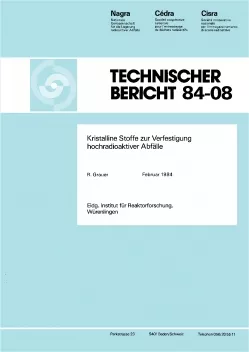
Technischer Bericht NTB 84-08
Kristalline Stoffe zur Verfestigung hochradioaktiver Abfälle
Highly active wastes from reprocessed nuclear fuels must be incorporated into a solid chemically resistant inorganic matrix prior to final storage. One possible alternative to glassification is to embed the complex oxide mixture in a crystalline ceramic.
A discussion from the structural and chemical viewpoint is presented giving guidelines for the selection and development of such a product. The chemical and phase composition concerning the most important developments are described.
SYNROC is the most highly developed solid ceramic that has been evaluated to date for power reactor wastes. However, its testing and development so far has been restricted to simulated inactive materials.
One of the most important aspects of solid high activity wastes is their behaviour in water. SYNROC reacts more slowly than glasses with water at temperatures over 100°C. Its low release of actinides under these conditions is remarkable. At temperatures under 100°C the important nuclide Cs137 is released from SYNROC and from glasses at comparable rates. These assertions concerning chemical stability are however based on short term experiments, which have not considered the possibly complex interactions occurring during final storage. The information is therefore insufficient to describe the basic model required to predict long term behaviour under final storage conditions.
Finally the report makes recommendations for a further programme of work.
